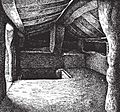Domus de Janas facts for kids

Domus de Janas are ancient tombs found in Sardinia, an island in Italy. Their name comes from the Sardinian words for "House of the Fairies" or "House of Witches." These special tombs were carved directly into rocks by people living in Sardinia long, long ago, even before the famous Nuragic civilization. They look a bit like small houses with several rooms inside.

People built these rock-cut tombs mostly between 3400 and 2700 BC. This was during the late Stone Age, the Copper Age, and the early Bronze Age. Some were even used during the Bell Beaker period.
Contents
Where to Find Domus de Janas
You can find many Domus de Janas all over Sardinia. One of the biggest groups of these tombs is at a place called Anghelu Ruju, near the city of Alghero. Here, there are 38 different tombs!
Other important sites include Montessu, close to Villaperuccio, and Sant'Andrea Priu in Bonorva. While most of Sardinia has these tombs, you won't find them in the Gallura area. In Gallura, people usually buried their dead in large stone circles, like those at Li Muri.
Inside the Tombs
The rooms inside the Domus de Janas can have different shapes. Some are round like a hut, with ceilings that are pointed or shaped like a cone. The walls inside these tombs often have special carvings or paintings. These designs show magical and religious symbols. You might see spirals, zig-zag patterns, or even bull's horns.
False Doors
About 20 of these tombs, mostly in northwestern Sardinia, have carved or painted "false doors." You can see examples of these at the necropolis of Anghelu Ruju. These false doors were made between about 3200 and 1600 BCE. Interestingly, some of the earliest false doors in Sardinia were made even before similar ones appeared in Ancient Egyptian tombs!
These false doors are usually found on the back wall of the main room. They look like a door frame with vertical and horizontal lines and a top piece. Sometimes, the false door has painted or carved U-shaped bull horns above it. These horns are often drawn or carved one inside the other.
What Was Buried Inside?
When people were buried in these tombs, their bodies were sometimes painted with red ochre, just like the tomb walls. They were buried with items they used in everyday life, like tools and jewelry.
Some experts believe the bodies were placed inside the tomb under shells from molluscs. Other ideas suggest that bodies might have been left outside the tomb first. Then, once they were just skeletons, they would be moved inside for their final resting place.
Gallery
-
Bull's horns, necropolis of Su Crucifissu Mannu, Porto Torres
-
Interior of one of the Domus de Janas of Sant'Andrea Priu, Bonorva.
-
Entrance of the domus de janas of Genna Salixi, Ruinas
-
Domus de Janas in Lotzorai
-
Necropolis of Arzolas de Goi, Nughedu Santa Vittoria
-
Pre-Nuragic false door topped with bull horns, from Putifigari
See also
 In Spanish: Domus de Janas para niños
In Spanish: Domus de Janas para niños
- History of Sardinia
- Pre-Nuragic Sardinia
- Necropolis of Santu Pedru
- Hypogeum
- Enchanted Moura










